| Article ID | Journal | Published Year | Pages | File Type |
|---|---|---|---|---|
| 933127 | Journal of Pragmatics | 2012 | 20 Pages |
This article analyses misalignment and the development of hostility in a series of three consecutive emergency calls by the same caller. Using Conversation Analysis as methodology, I show how problems of establishing intersubjective understanding and interactional alignment led to spiraling hostility, ending in aggravated conflict involving insults and threats. The focus of analysis is on the operators’ displays of hearing, understanding and acceptance of the caller's request. The first type of misalignment involves the establishment of mutual understanding concerning the location and the physical state of the patient. Second, problems of alignment are caused by the operators withholding displays of acceptance, substituting such receipts by continued interrogation. The development of hostility follows a pattern where this alleged lack of response is treated as potential rejection and made the object of complaints by the caller. The caller's complaints are in turn met by reproaches for improper behavior and by requests to “calm down”, sparking off even more emotional complaints. The analysis thus shows how problems of alignment may lead to conflict by the participants’ treating each others’ disaligning actions as indications of uncooperativeness and hostility.
► The development of conflict in emergency calls follows a recurring pattern. ► Operators’ failure to display understanding and acceptance may generate hostility. ► Continued interrogation may be treated as potential rejection. ► Requests to “calm down” may be heard as complaints and lead to more hostility. ► Callers’ complaints to operators may occasion complaints or reproaches in return.
